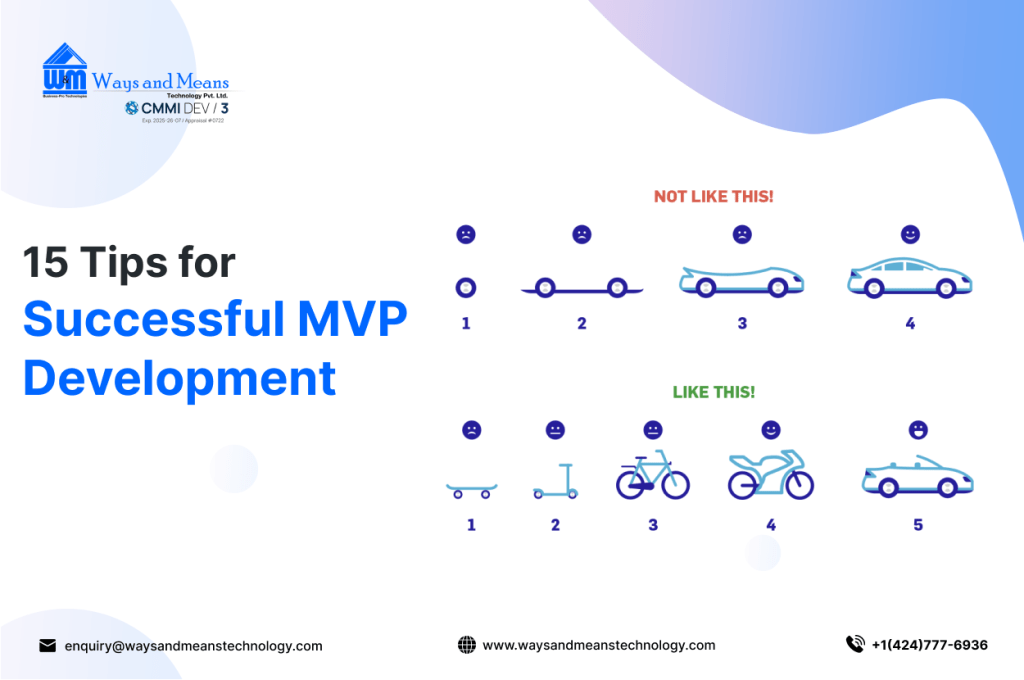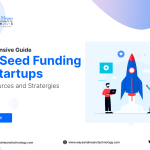- Start with a lean startup mindset to minimize waste and maximize learning.
- Identify and validate your product-market fit to ensure there is a demand for your product.
- Use agile development methodologies to enable rapid iteration and quick feedback loops
- Conduct user testing early and often to gain insights into user behavior and identify areas for improvement.
- Use rapid prototyping to test and refine your MVP quickly and efficiently
- Focus on iterative development to make incremental improvements to your product over time
- Identify the minimum viable features that your product needs to launch and test with early adopters.
- Use a business model canvas to map out your business model and identify key value propositions.
- Conduct customer discovery to gain a deeper understanding of your target audience and their needs
- Define your key metrics for success and track them closely to ensure you are meeting your goals
- Focus on delivering a high-quality user experience to drive engagement and adoption
- Build a strong brand and identity to differentiate yourself from competitors
- Use data analytics to gain insights into user behavior and make data-driven decisions
- Focus on creating a product that is scalable and can be easily adapted to changing market conditions
- Emphasize transparency and communication with your team and stakeholders to ensure everyone is aligned and moving in the same direction
- How Ways and Means Technology can help you build your MVP and bring your idea to life ?
- Frequently Asked Questions
1. Start with a lean startup mindset to minimize waste and maximize learning.

A lean startup mindset involves using a combination of experimentation, validated learning, and iteration to build a business. By minimizing waste and focusing on learning, startups can quickly test and refine their MVP to meet the needs of their target audience.
For example, Airbnb started with a simple website that allowed people to rent out air mattresses in their living rooms. Through experimentation and iteration, they were able to validate their business model and grow into the world’s largest vacation rental platform.
2. Identify and validate your product-market fit to ensure there is a demand for your product.
Product-market fit is the degree to which a product satisfies a strong market demand. Startups should aim to identify and validate their product-market fit as early as possible to ensure that there is a demand for their product. For example, Dropbox started as a simple file sharing tool, but quickly pivoted to focus on cloud storage after identifying a strong demand from users.
3. Use agile development methodologies to enable rapid iteration and quick feedback loops
Agile development involves using an iterative approach to software development, with a focus on delivering working software in short timeframes. By using agile development methodologies, startups can quickly test and refine their MVP to meet the needs of their target audience. For example, Spotify uses agile development to continually improve their product based on customer feedback.
Also Read: Creating an MVP that Impresses Investors: Tips for Securing Funding for Your Mobile App
4. Conduct user testing early and often to gain insights into user behavior and identify areas for improvement.
User testing involves getting feedback from users on a product or feature. By conducting user testing early and often, startups can gain valuable insights into user behavior and identify areas for improvement for their MVP. For example, Airbnb conducts user testing on a regular basis to improve the user experience on their platform.
5. Use rapid prototyping to test and refine your MVP quickly and efficiently

Rapid prototyping involves creating a working model of a product in a short amount of time. By using rapid prototyping, startups can quickly test and refine their MVP to meet the needs of their target audience. For example, Twitter used rapid prototyping to quickly develop and test their MVP to meet the needs of their users.
6. Focus on iterative development to make incremental improvements to your product over time
Iterative development involves making incremental improvements to a product over time. By focusing on iterative development, startups can continually improve their MVP based on user feedback and changing market conditions. For example, Amazon uses iterative development to make small improvements to their product on a regular basis.
7. Identify the minimum viable features that your product needs to launch and test with early adopters.
Minimum viable features are the minimum set of features that a product needs to launch and be successful. By identifying the minimum viable features for their MVP, startups can quickly test their product with early adopters to gain feedback and improve their product. For example, Dropbox initially launched with a simple file sharing feature to test with early adopters.
8. Use a business model canvas to map out your business model and identify key value propositions.
A business model canvas is a visual representation of a company’s business model, which identifies key value propositions, target customers, and revenue streams. By using a business model canvas, startups can identify key value propositions and target customers for their MVP. For example, Uber used a business model canvas to identify key value propositions for their ride-sharing platform.

9. Conduct customer discovery to gain a deeper understanding of your target audience and their needs
Customer discovery involves getting feedback from potential customers to gain a deeper understanding of their needs and pain points. By conducting customer discovery, startups can identify key value propositions for their MVP and ensure that their product meets the needs of their target audience. For example
a startup building a new workout app might conduct customer discovery to understand the pain points of gym-goers, such as a lack of motivation, and then create features that address those pain points, such as personalized workout plans and social features that encourage accountability.
10. Define your key metrics for success and track them closely to ensure you are meeting your goals
Key metrics are the specific indicators that a company uses to measure success. By defining and tracking key metrics closely, startups can ensure they are meeting their goals and making progress towards their desired outcomes. For example, a startup launching a new e-commerce platform might track key metrics such as conversion rates, customer acquisition costs, and customer lifetime value to ensure they are meeting their business goals.
11. Focus on delivering a high-quality user experience to drive engagement and adoption
A high-quality user experience is essential for driving engagement and adoption of a product. By focusing on delivering a high-quality user experience, startups can ensure that their MVP is easy to use, intuitive, and visually appealing. For example, the user experience of Apple’s products is often cited as a key factor in their success.
12. Build a strong brand and identity to differentiate yourself from competitors
A strong brand and identity can help a startup differentiate itself from competitors and build a loyal customer base. By building a strong brand and identity, startups can establish themselves as a leader in their industry and create a unique value proposition for their MVP. For example, Airbnb has built a strong brand and identity around the idea of “belonging,” which has helped them stand out in the crowded vacation rental market.
13. Use data analytics to gain insights into user behavior and make data-driven decisions
Data analytics involves using data to gain insights into user behavior and make data-driven decisions. By using data analytics, startups can identify patterns in user behavior, track key metrics, and make informed decisions about how to improve their MVP. For example, Netflix uses data analytics to track user behavior and make data-driven decisions about content acquisition and development.
Also Read: Key Aspects of building tech Startup
14. Focus on creating a product that is scalable and can be easily adapted to changing market conditions
Scalability is essential for startups that want to grow quickly and adapt to changing market conditions. By focusing on creating a product that is scalable and can be easily adapted, startups can ensure that they can respond quickly to changes in the market and continue to grow over time. For example, Amazon’s cloud computing platform, AWS, is designed to be highly scalable and easily adaptable to changing market conditions.

15. Emphasize transparency and communication with your team and stakeholders to ensure everyone is aligned and moving in the same direction
Transparency and communication are essential for ensuring that everyone on a team is aligned and moving in the same direction. By emphasizing transparency and communication, startups can ensure that everyone understands the goals of the MVP, their role in achieving those goals, and how progress is being measured. For example, Google places a strong emphasis on transparency and communication with its employees to ensure that everyone is aligned and working towards the same goals.
How Ways and Means Technology can help you build your MVP and bring your idea to life ?
Are you a startup founder with an idea for a new product? Do you need help turning that idea into a Minimum Viable Product (MVP) quickly and efficiently? Look no further than Ways and Means Technology!
At Ways and Means Technology, we have years of experience developing MVPs for startups across a range of industries. Our skilled development team will work with you to refine your product idea, create a detailed development plan, and deliver a high-quality MVP that meets your needs.
Our MVP development process is clear and streamlined, ensuring that you get the product you need without wasting time or money. We understand that startups need to move quickly, so we work hard to deliver MVPs on time and within budget. And, we will provide regular updates and feedback throughout the development process, so you are always in the loop.
So, whether you have a new app, website, or software product, Ways and Means Technology can help you create a successful MVP. Contact us today to learn more about how we can help you turn your idea into a reality.

Frequently Asked Questions
What is your experience in developing MVPs for startups, and can you provide examples of your work?
At Ways and Means Technology, we have years of experience developing MVPs for startups across a range of industries. We can provide you with case studies and examples of our previous work to showcase our expertise and the quality of our work.
How Ways and Means Technology can help: Our extensive experience in developing MVPs for startups means that we understand the unique challenges that startups face and can offer tailored solutions to meet your specific needs.
What is your MVP development process, and how do you ensure that the MVP meets my needs?
At Ways and Means Technology, we have a clear and streamlined MVP development process that ensures we understand your needs and deliver a high-quality MVP that meets your goals. We work with you to refine your product idea, create a detailed development plan, and deliver regular updates and feedback throughout the development process.
How Ways and Means Technology can help: Our clear and efficient MVP development process ensures that you get the product you need without wasting time or money.
How do you ensure that the MVP is delivered on time and within budget?
At Ways and Means Technology, we understand that startups need to move quickly, and we work hard to deliver MVPs on time and within budget. We provide regular updates and feedback throughout the development process to ensure that we are meeting your needs and delivering the MVP within the agreed timeframe and budget.
How Ways and Means Technology can help: Our focus on delivering MVPs on time and within budget means that you can rely on us to meet your needs and help you move your startup forward.
What level of support do you provide after the MVP is delivered?
At Ways and Means Technology, we provide ongoing support after the MVP is delivered to ensure that it continues to meet your needs and evolves as your business grows. We offer maintenance and support services, as well as additional development services to help you scale your product.
How Ways and Means Technology can help: Our ongoing support and development services mean that you can rely on us to help you scale your product and achieve your business goals.


